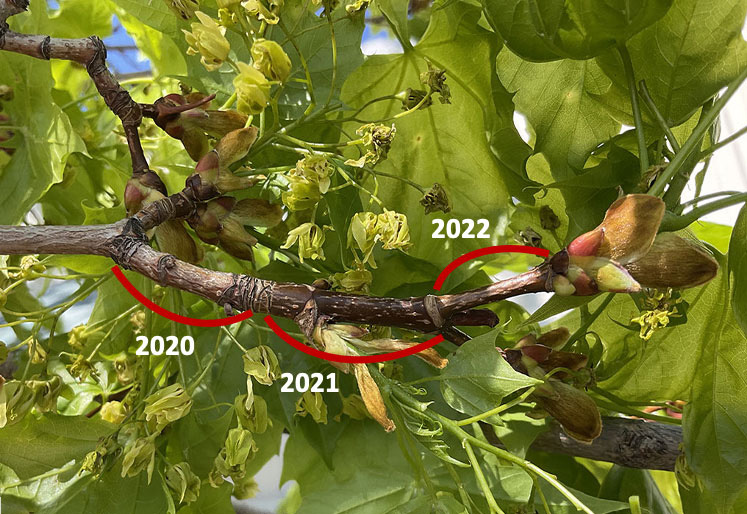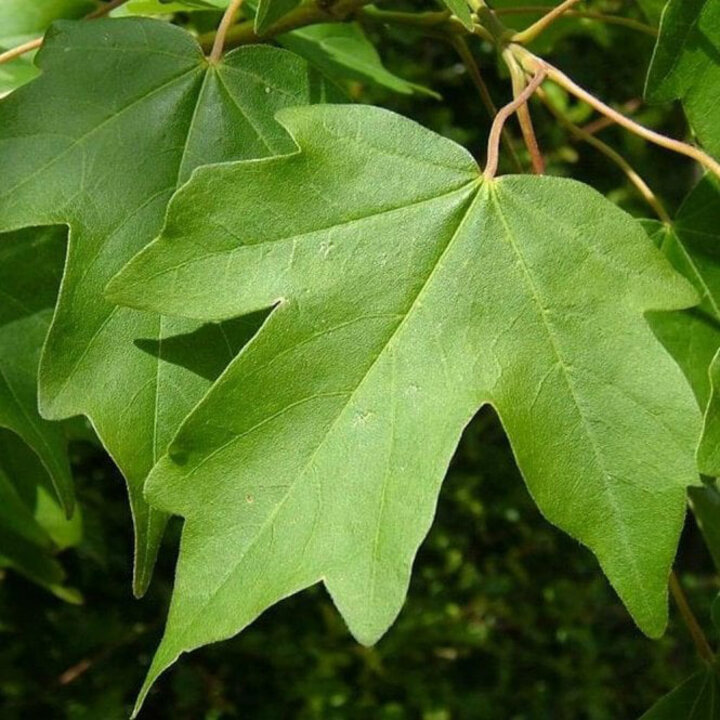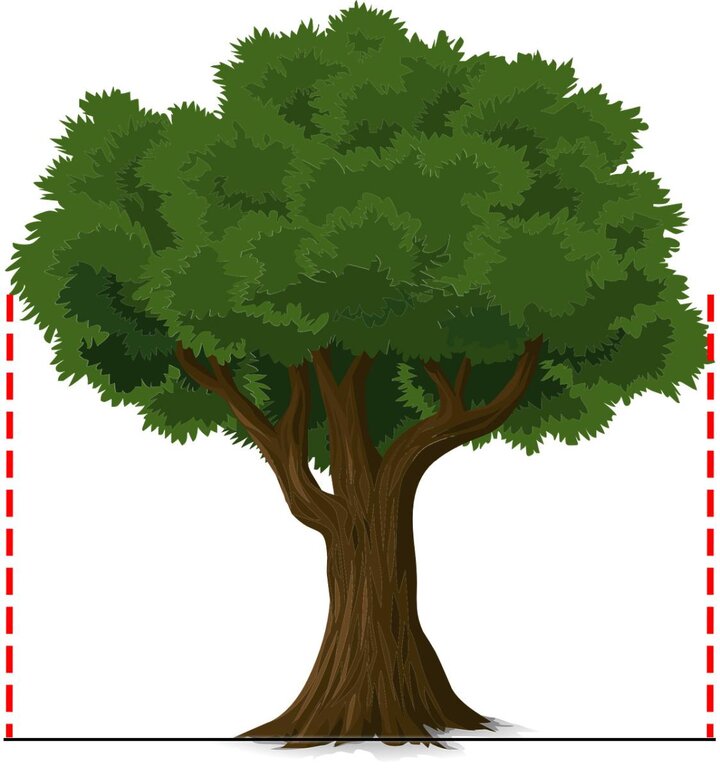Sarah Browning, Nebraska Extension Educator

Less than 6" of new growth each year on a well-established tree may indicate there is a problem. Sarah Browning, Nebraska Extension Educator.
We fertilize our lawns regularly each year, but do trees need fertilization, too? Actually, in most cases - no. Most Nebraska soils are fertile enough to support good growth of trees and shrubs without the need for additional fertilization. And in particular, trees surrounded by a fertilized lawn don't need additional fertilization.

But how can you tell if your tree is the exception and could benefit from additional fertilization? Vigorous growth is a good indication no additional nutrients are needed. However, if a tree shows the following symptoms - only small amounts of new growth each year, small leaves, off-colored yellow leaves and/or poor canopy fill - these are indications the tree is struggling. Typically, a healthy tree should produce at least six inches of new growth each year.
But first, rule out the possibility your tree is suffering from environmental problems - like drought or overwatering - planting and root issues, and disease or insect problems before considering fertilization. If the underlying problem isn't addressed, fertilization alone won't overcome it and could potentially make it worse.
Factors Contributing to Soil Nutrient Deficiencies
Trees growing in severely eroded soils, very sandy soils, or soil disturbed by new construction may exhibit some of the symptoms mentioned above and benefit from additional nutrients.
Landscape trees and shrubs are frequently subject to adverse soil and environmental conditions. Removal of topsoil and compaction of the remaining subsoil during home construction leaves many landscapes with poor soil for plant growth. Poor soil drainage, competition from grass sod, and highly alkaline soil pH levels are additional factors contributing to poor tree and shrub root growth, which may express itself as nutrient deficiencies. Supplemental nutrients may sometimes be needed to help trees maintain vigor in these landscapes, but addressing the overall poor soil conditions is the best long-term solution.

When to Fertilize
Supplemental fertilization is most beneficial during periods of maximum plant growth. The ideal time to fertilize is in spring, just after trees have fully expanded. This allows trees to maximize the amount of fertilizer taken up by the roots and used by the growing tree. Woody plants take up nutrients through their root systems and, in most cases, respond best to soil applications of fertilizers.
Fall applications, once leaf drop begins and before the ground freezes, are the second best time to fertilize, however, considerable amounts of nitrogen may be lost to leaching during the winter months. Do not apply fertilizer to frozen soil.
Do not apply fertilizer:
- In late summer, August and September, which may promote growth flushes that are very succulent and could be easily damaged by the freezing temperatures of early autumn.
- During the first year for newly planted trees, since this can create an unbalanced leaf canopy-to-root ratio.
- For newly transplanted large trees, it is best to wait several seasons for the root system to become re-established before fertilizing.Nitrogen fertilization promotes leaf growth. A newly transplanted tree, which lost most of its root system during removal from the production field, needs to reestablish roots first and may be forced into excess leaf growth, for which the current root system cannot adequately provide water, if the tree is fertilized.

What Nutrients are Needed?
Nebraska soils typically have high levels of phosphorus and potassium, so additional fertilization with these nutrients is seldom needed. If a soil analysis indicates the phosphorus level is below 6 ppm (Bray #1) or 4 ppm (sodium bicarbonate), or potassium is below the range of 75 ppm (extractable K), then applications of one or both of these nutrients would be beneficial for tree and shrub growth.
Nitrogen is the most frequently limiting nutrient for plant growth, but completing a soil test to determine existing nutrient levels is a good idea before additional fertilizer is applied.
Phosphorus and nitrogen runoff are frequent polluters of lakes, ponds and streams, resulting in heavy algae development. Many states restrict the use of phosphorus in landscape fertilizers for this reason.
Calculating the Amount of Nitrogen Fertilizer Needed
First, determine the number of square feet under the tree’s canopy - the area from the tree's trunk to the edge of the widest branches. To do this, measure this distance, then use the following formula to calculate the area of a circle. Square feet of circle = 3.14 x radius × radius. The radius is the distance from the trunk to the edge of the widest branches.
Next, the actual pounds of fertilizer product to be applied are calculated based on the product you purchase and it's nitrogen concentration. Recommended rates are 1.5 lb actual nitrogen, or 1 lb actual phosphorus or potassium per 1,000 square feet of area under the tree's drip line or a shrub's bed area.
Example: With a tree canopy radius equal to 20 feet, the formula would be the following.
- Area = 3.14 × 20 × 20 = 1,256 square feet.
- Actual nitrogen needed would equal 1.5 lb N × 1,256 sq.ft. /1,000 = 1.9 lb N.
- If the fertilizer purchased has 20% N composition, the amount of fertilizer needed would then be 1.9/.20 = 9.5 lb of fertilizer.
Making Applications
Most trees don't need supplemental fertilization, plus unnecessary or over application of fertilizer makes trees more susceptible to insect and disease problems and drought injury. So don't fertilize your trees unless deficiency symptoms are seen and other contributing factors are ruled out. However, if fertilization is needed, then granular applications are the most cost-effective method.
Granular Fertilizer Applications. Due to the potential damage to grass under trees, surface applications for woody plants where good grass cover is present should not exceed 1.5 lb. actual nitrogen per 1,000 square feet of ground area per application. This will reduce the risk of "burning" the grass.
Fertilizer can be applied with a spreader calibrated to apply the recommended amount. Start 2 to 3 feet from the trunk and move outward in concentric circles until you reach 2 to 3 feet beyond the drip line (end of branches). Care should be taken to avoid overlapping your circles. Immediately irrigate to move fertilizer into the soil profile.
Fertilizer Spikes. These products are a convenient and simple way to apply fertilizer and can be effective if used in sufficient quantities. However, they are a more expensive alternative when compared to granular fertilizer.
Images
- Healthy trees have full-size, medium to dark green leaves. Image from the Nebraska Statewide Arboretum.
- The square footage of a tree canopy includes all the soil beneath the tree's dripline or the area from the trunk to the edge of the widest branches. Image is a free use vector graphic.
- Nutrient content on a fertilizer bag is listed as percentage per pound and nutrients are always listed in order - nitrogen, phosphorus and potassium. Image is a free use vector graphic.
Search Our Archive
Associated Video
New Tree Care
UNL Assistant Director for Landscape Operations Jeff Culbertson talks about new trees planted around a new residence hall on east campus.